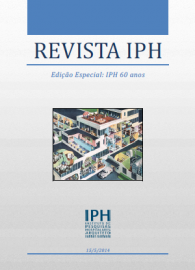Publications IPH Magazine Special: 60th Anniversary Communication and Leadership in Health Institutions

- EDITORIAL
- Future Trends in Teaching and Research Hospital Design
- Jarbas Karman and the Hospital Architecture
- Surgical Centers: An Approach
- Acoustic Comfort In Healthcare Environments: Music, Landscape And Cladding Material As Humanizing Solutions
- Hospital Engineering and Maintenance: Committing To Maintaining Lives
- Communication and Leadership in Health Institutions
- The Relationship Between Professionals And Patients In The Health Sector - Tendencies And Perspectives
Communication and Leadership in Health Institutions
Teresinha Covas Lisboa
When these capacities are given the right importance we have a healthy environment, one that is flexible towards change and integration.
"Leadership is the person's ability to spontaneously gather people around an idea, a principle, a philosophy or a goal"
(Rodriguez, 2005).
Communication is used as a process of interaction among people and it has been used as a tool to solve conflicts and change behaviors within organizations.
The multidisciplinary nature of health institutions can sometimes cause dispersion and conflicts in communication, which is justified by numberless urgencies and emergencies that fall upon this environment on a daily basis. The administrative approach needed to understand the structure is still not present in many institutions. And in order for the correction to work effectively it is of high importance for the leaderships to interfere.
The multidisciplinary nature of health institutions can sometimes cause dispersion and conflicts in communication, which is justified by numberless urgencies and emergencies that fall upon this environment on a daily basis. The administrative approach needed to understand the structure is still not present in many institutions. And in order for the correction to work effectively it is of high importance for the leaderships to interfere.
The proactive leadership needs to have the ability and the concern to face conflicting situations that may emerge from a poorly planned communication process. Nonetheless, we are aware of the fact that verbal signals, gestures and body language when misunderstood by the receptor are a consequence of the talker's lack of communication. Health professionals need to be constant assessed on the means of communication they use when seeing their patients so mistakes do not linger on. Such fact can be proved by the nurse team's performance, which is very active and sensitive when using gestures and eye contact, since their own education provides them with it. The leaderships in nursing services invest on the ongoing training and education of their collaborators, aiming at better work conditions for their professionals.
Leaders must analyze the available resources in face of the diagnosis of training and development necessity, targeting planning and control concerning the accomplishment of tasks. Some doubts guide the process: the Operational Standard Procedures are well established, communicated, implanted and evaluated? Are they responding to the demand and the organizational inner flow? Will the answers to these questions guide the leaders towards the correction of the process? Then other questions are asked: are there new ideas and is the change of procedures being innovated? How were they communicated? Will the answers to these questions guide the leaderships towards the correction of the process and its feedback?
It is worth highlighting that some professionals are excessively resistant to change and conservatism prevails on the day-by-day delaying the correction. Another aspect is updating the "communication" function, whose interest is aimed to the interpersonal relationships, people's motivation and the means through which the work is undertaken. Through the constant evaluations obtained we proceed with the updating and, therefore, put in practice corrections that will feed the strategic planning process of the evaluated unity and organization.
When the leadership values employees and encourages their participation in order to integrate them to the company's mission and goals, the communication is considered to be effective.
Developing a communication program uses a strategy addressed to creating mechanisms that inform the organization about data concerning mission, vision, goals, results, institution's policies, programs and internal campaigns. It is, therefore, an integrating net as well as a way of creating or widening a channel for free expression and participation of all the company's operational, tactics and strategic levels. For that to happen it is necessary to organize periodic meetings, inside or outside the company, between leaderships and employees. There are motivational programs, posters, actions and practices per department that can be developed to meet this end.
Communication is about quality of life in the working place, especially when concerning the interpersonal relationships, and to be accomplished some measures must be taken by the leaderships. First of all, we must consider the verbal collocations of employees, as well as the cultural and social differences among them. We can use as an example the operational employees (laundry, cleaning, maintenance, security, nutrition etc.), they need more explanatory and visual communication and also more time and attention for their questions and queries regarding the tasks and the organization. In addition, the informal relationships measure the levels of communication and the existent interpersonal conflicts.
Currently the Hospitality Service has been offering great help in the communication between the unities and the leaderships, since it is addressed towards the direct service to the patient.
This is a service that offers an important feedback to the leaderships.
Lisboa believes that the Hospitality Service is a collective of the services available to both internal and external clients that aims to offering conditions for comfort, well-being, assistance, safety, quality and humanization in service, gathering all the professional practices available in health institutions. Consequently, the search for this goal will lead to the integration of the teams (2008).
This service targets at: promoting the client's satisfaction, offering support to the assistance, keeping hygiene standards, taking care of work safety, providing high quality food, cares for the institution's patrimony, interacting in the release and sell of hospital vacancies and following up with the post-treatment. It is also important to observe the truth, the justice, the ethics and the respect, all strong issues present in an organization whose main concern is a good organizational environment and that is preoccupied with providing health services to the community.
It is necessary however to offer a space so the collaborator consider this environment as being a "good place to work". Finally, it is needed to use evaluation tools to assess the information, correcting flaws and misunderstandings just after some improper situation happens.
The observations made by users of the service must be evaluated in an informal manner. Small actions are enough to bring together leaderships and collaborators, such as breakfasts, meetings, dynamics etc.
Therefore the existent challenges faced by the leaderships concerning the communication in health organizations are connected with people's compromise and motivation. The health environment is very dynamic and immediate; hence it needs collaborators who are in balance with the inner environment. The image of the leaders in this context is of trust, for the collaborators trust their judgment, character and intelligence.
We cannot stress it enough that when we talk about communication and leadership we must list five necessary competencies for the management process mentioned by Fundação Dom Cabral that also fit the health universe:
- Self-knowledge: related to Emotional Leaderships characteristics.
- People Development: related to the leader willing to educate, transform and develop other leaders. It is the leadership concerned with the "succession line".
- Emotional self-control: it is the consequence of the leaderships that have the capacity of acknowledging their emotions and control them when necessary.
- Clarity and Assertiveness: leaderships' capacity to express their ideas, orientations and guidance to then practice communication.
- Inspiration: the capacity to inspire and engage others.
When these capacities are given the right importance we have a healthy environment, one that is flexible towards change and integration.
Communication is therefore connected to the image of the organization, which means how it is evaluated and perceived, helping engagement and motivation between leaders and the people being led.
References
LISBOA, Teresinha Covas. Gestão dos Serviços: limpeza, higiene e lavanderia em estabelecimentos de saúde. 3ª.ed. São Paulo: Sarvier, 2008.
OLIVEIRA, Jayr Figueiredo de (coord.). Profissão líder: desafios e perspectivas. São Paulo: Saraiva, 2006.
OLIVEIRA, Jayr Figueiredo de; MARINHO, Robson M. Liderança: uma questão de competência. São Paulo: Saraiva, 2006.
RODRIGUEZ, Edson. Conseguindo resultado através das pessoas: seu sucesso depende dos outros. Rio de Janeiro: Negócio Editora, 2005.
YAMAMOTO, Marcos. Como nascem os líderes. Revista Administrador Profissional. CRA-SP. Ano 37, nº 333, Março/2014, p. 20 a 22.
Related Content
Send by e-mail:



